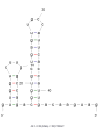Computational analysis and determination of a highly conserved surface exposed segment in H5N1 avian flu and H1N1 swine flu neuraminidase
- PMID: 20170556
- PMCID: PMC2836360
- DOI: 10.1186/1472-6807-10-6
Computational analysis and determination of a highly conserved surface exposed segment in H5N1 avian flu and H1N1 swine flu neuraminidase
Abstract
Background: Catalytic activity of influenza neuraminidase (NA) facilitates elution of progeny virions from infected cells and prevents their self-aggregation mediated by the catalytic site located in the body region. Research on the active site of the molecule has led to development of effective inhibitors like oseltamivir, zanamivir etc, but the high rate of mutation and interspecies reassortment in viral sequences and the recent reports of oseltamivir resistant strains underlines the importance of determining additional target sites for developing future antiviral compounds. In a recent computational study of 173 H5N1 NA gene sequences we had identified a 50-base highly conserved region in 3'-terminal end of the NA gene.
Results: We extend the graphical and numerical analyses to a larger number of H5N1 NA sequences (514) and H1N1 swine flu sequences (425) accessed from GenBank. We use a 2D graphical representation model for the gene sequences and a Graphical Sliding Window Method (GSWM) for protein sequences scanning the sequences as a block of 16 amino acids at a time. Using a protein sequence descriptor defined in our model, the protein sliding scan method allowed us to compare the different strains for block level variability, which showed significant statistical correlation to average solvent accessibility of the residue blocks; single amino acid position variability results in no correlation, indicating the impact of stretch variability in chemical environment. Close to the C-terminal end the GSWM showed less descriptor-variability with increased average solvent accessibility (ASA) that is also supported by conserved predicted secondary structure of 3' terminal RNA and visual evidence from 3D crystallographic structure.
Conclusion: The identified terminal segment, strongly conserved in both RNA and protein sequences, is especially significant as it is surface exposed and structural chemistry reveals the probable role of this stretch in tetrameric stabilization. It could also participate in other biological processes associated with conserved surface residues. A RNA double hairpin secondary structure found in this segment in a majority of the H5N1 strains also supports this observation. In this paper we propose this conserved region as a probable site for designing inhibitors for broad-spectrum pandemic control of flu viruses with similar NA structure.
Figures



Similar articles
-
Graphical representation and numerical characterization of H5N1 avian flu neuraminidase gene sequence.J Chem Inf Model. 2007 May-Jun;47(3):945-51. doi: 10.1021/ci600558w. Epub 2007 Apr 7. J Chem Inf Model. 2007. PMID: 17417832
-
Insights from investigating the interaction of oseltamivir (Tamiflu) with neuraminidase of the 2009 H1N1 swine flu virus.Biochem Biophys Res Commun. 2009 Aug 28;386(3):432-6. doi: 10.1016/j.bbrc.2009.06.016. Epub 2009 Jun 10. Biochem Biophys Res Commun. 2009. PMID: 19523442
-
On the structure-based design of novel inhibitors of H5N1 influenza A virus neuraminidase (NA).Biophys Chem. 2009 Mar;140(1-3):35-8. doi: 10.1016/j.bpc.2008.11.004. Epub 2008 Nov 20. Biophys Chem. 2009. PMID: 19117662
-
Recent advances in neuraminidase inhibitor development as anti-influenza drugs.ChemMedChem. 2012 Sep;7(9):1527-36. doi: 10.1002/cmdc.201200155. Epub 2012 Jul 16. ChemMedChem. 2012. PMID: 22807317 Review.
-
Laninamivir octanoate: a new long-acting neuraminidase inhibitor for the treatment of influenza.Expert Rev Anti Infect Ther. 2011 Oct;9(10):851-7. doi: 10.1586/eri.11.112. Expert Rev Anti Infect Ther. 2011. PMID: 21973296 Review.
Cited by
-
Rational Design of Peptide Vaccines Against Multiple Types of Human Papillomavirus.Cancer Inform. 2016 Jun 1;15(Suppl 1):1-16. doi: 10.4137/CIN.S39071. eCollection 2016. Cancer Inform. 2016. PMID: 27279731 Free PMC article.
-
In silico study of rotavirus VP7 surface accessible conserved regions for antiviral drug/vaccine design.PLoS One. 2012;7(7):e40749. doi: 10.1371/journal.pone.0040749. Epub 2012 Jul 26. PLoS One. 2012. PMID: 22844409 Free PMC article.
-
A Brief Review of Computer-Assisted Approaches to Rational Design of Peptide Vaccines.Int J Mol Sci. 2016 May 4;17(5):666. doi: 10.3390/ijms17050666. Int J Mol Sci. 2016. PMID: 27153063 Free PMC article. Review.
-
Theoretical analysis of the neuraminidase epitope of the Mexican A H1N1 influenza strain, and experimental studies on its interaction with rabbit and human hosts.Immunol Res. 2013 May;56(1):44-60. doi: 10.1007/s12026-013-8385-z. Immunol Res. 2013. PMID: 23371837
-
Graphical representation and mathematical characterization of protein sequences and applications to viral proteins.Adv Protein Chem Struct Biol. 2011;83:1-42. doi: 10.1016/B978-0-12-381262-9.00001-X. Adv Protein Chem Struct Biol. 2011. PMID: 21570664 Free PMC article. Review.
References
-
- Haolum J, Choung UK. Design of Neuraminidase Inhibitors as Anti-influenza Virus Agents. Advances in Antiviral Drug Design. 2004;4:99–117.
-
- Lal SK, Chow VTK. Avian Influenza H5N1 Virus: An Emerging Global Pandemic. Issues Infect Dis Basel, Karger. 2007;4:59–77.
-
- Pasick J, Handel K, Robinson J, Copps J, Ridd D, Hills K, Kehler H, Cottam-Birt C, Neufeld J, Berhane Y, Czub S. Intersegmental recombination between the haemagglutinin and matrix genes was responsible for the emergence of a highly pathogenic H7N3 avian influenza virus in British Columbia. J Gen Virol. 2005;86:727–731. doi: 10.1099/vir.0.80478-0. - DOI - PubMed
Publication types
MeSH terms
Substances
LinkOut - more resources
Full Text Sources
Medical

